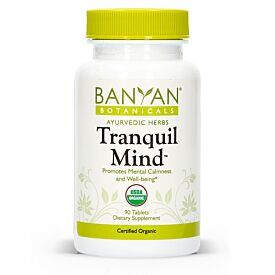Yoga and Ayurveda
Yoga and Ayurveda are two interrelated branches of the same great tree of Vedic knowledge that encompasses all human life and the entire universe. In this regard, it is important to understand the respective roles of Ayurveda and Yoga in the Vedic system.
In this Article:
- Yoga as Therapy
- Yoga Therapy Today
- A Yogic System of Medicine is Required
- Yoga as a Psychology
- Closing Thoughts
Vedic knowledge is the ancient mantric science of the seers and yogis of India designed to show us the inner workings of the universe and of our own consciousness, leading us ultimately to the state of Self-realization and liberation from the cycle of birth and death.
To this end, it has given us not only spiritual disciplines but has touched all aspects of healing, science, art, and culture.
Ayurveda is one of the four Upavedas or secondary Vedic teachings, along with Gandharva Veda (music), Sthapatya Veda (directional science), and Dhanur Veda (martial arts). These Upavedas apply Vedic knowledge along specific lines to supplement the Vedic quest for wholeness and liberation.
Yoga—particularly in its formation through the Yoga Sutras of Patanjali—is one of the six systems of Vedic philosophy (shad darshanas). These are the systems of Indian philosophy that accept the authority of the Vedas and try to systematize the meaning of the Vedic teachings.
The other Vedic systems include Nyaya (Logic), Vaisheshika (Categorization), Samkhya (Enumeration of Cosmic Principles), Purva Mimamsa (Ritual), and Uttara Mimamsa (Vedanta or Metaphysics).
Yoga to some extent pervades all the six systems and represents their practical side, outlining the prime principles and methods for developing the meditative mind that is the basis of all Vedic knowledge.
In this classical Vedic scheme, Ayurveda is the Vedic system developed specifically for healing purposes. There is no other Vedic system of healing apart from Ayurveda. Yoga is the Vedic system of spiritual practice or sadhana. All Vedic sadhana or spiritual practice involves some form of Yoga practice.
This means that Yoga is not originally or inherently a medical system. It does not address either physical or psychological disease or their treatment in a primary manner. Yoga aims at relieving spiritual suffering, which it defines according to the kleshas or spiritual afflictions starting with ignorance (avidyà) of our true nature as pure consciousness, which leads us to a false identification of ourselves with our transient bodies and minds.
This does not mean that we cannot use aspects of Yoga medically, but that this is not its primary intent or orientation. To do so would require applying Yoga in a different manner than what it was originally meant to be.
If our aim is to turn Yoga into a medical system, in the Vedic scheme this requires turning Yoga in the direction of Ayurveda. Yoga for healing should be applied according to Ayurvedic guidelines of diagnosis, treatment, and health maintenance if we want to keep yogic healing within the scope of Vedic knowledge.
In fact, there was never any yogic system of medicine in India apart from Ayurveda historically, not only among the followers of the Vedic tradition but also among the followers of non-Vedic traditions. Even Buddhist medicine in India and Tibet has been primarily Ayurveda.

Yoga as Therapy
The term for therapy in Sanskrit is Chikitsa. Ayurvedic textbooks like Charak, Sushruta, and Vagbhatta all contain sections called Chikitsa Sthana, or “section relating to chikitsa or treatment.”
They have complementary sections like Nidana Sthana, or diagnosis, and Sharira Sthana, which relates to the embodied soul and includes the anatomy and physiology of the physical body.
The Ayurvedic view of our embodied nature (body, mind, and soul) and how it works, the causes of disease and the treatment of disease are all connected in a beautiful, clear, and wonderful system of optimal health and total well-being.
Ayurveda addresses all aspects of medicine—including diet, herbs, drugs, surgery, bodywork, and its own special clinical procedures like panchakarma. It brings in ritual, mantra, and meditation for healing the mind.
In addition, Ayurveda provides lifestyle recommendations for health, longevity, and disease prevention as well as special methods for rejuvenation of body and mind. It includes the practices of Yoga from asana and pranayama to mantra and meditation as part of its healing tools.
Yoga texts like the Yoga Sutras have sections like Samadhi Pada (deep meditation), Sadhana Pada, (spiritual practice), Vibhuti Pada (yogic powers), and Kaivalya Pada (liberation).
The yogic exploration of consciousness, the subtle energies of prana and mind, and various types of spiritual practices are all inter-connected. Yogic texts contain discussions of meditation, concentration, mantra, ritual, pranayama, asana, and related factors but as part of spiritual practice, not as a therapy.
We do not find any Chikitsa Padas or therapy sections in the usual Yoga texts. The term Chikitsa does not occur in the Yoga Sutras of Patanjali and is not a major topic of concern in Yoga philosophy.
This is because the concern of classical Yoga is Sadhana, not Chikitsa, which was regarded as the field of Ayurveda. Most importantly, we do not find in Yoga texts a discussion of disease, pathology, diagnosis, or treatment strategies apart from the approach of Ayurveda. There is no Yoga system of medicine in terms of diagnosis, pathology, and treatment, apart from Ayurveda.
What we do find commonly in Yoga texts are discussions of the pranas, senses, mind, nadis, and chakras, worship of deities, discussion of the inner Self and nature of consciousness, as well as the types of samadhi or inner absorption.
Disease is addressed briefly in some Yoga texts as it is regarded as one of the main obstacles to Yoga practice. But when this does occur, the language of Ayurveda is usually employed.
Yoga Therapy Today
Modern Yoga has defined itself primarily in terms of asanas or physical postures. These are usually taught en masse in exercise classes for people primarily seeking physical well-being.
We commonly identify Yoga teachers as those who conduct asana classes. Some of these Yoga teachers may have some knowledge of the greater system of classical Yoga. This situation impacts what is popularly regarded as Yoga therapy, which is colored by the Yoga as asana emphasis.
Yoga therapy or Yoga Chikitsa is a new, popular, and powerful movement in Yoga today that is still trying to define itself and its scope of application. However, for the most part, modern Yoga therapy, following the asana as Yoga model, consists primarily of an adaptation of asanas or asana styles to treat disease and improve health.
This view of Yoga is different from and a reduced version of classical Yoga that is defined primarily in terms of spiritual practice and deep meditation (sadhana and samadhi).
Any therapy must rest upon a system of medicine for diagnosis and overall treatment strategies. A therapeutic method—whether herbs, drugs, asana, or pranayama—cannot be applied independently of a medical orientation and an examination of the patient as a whole.
Modern Yoga therapy largely consists of the application of Yoga asanas as an adjunct physical therapy for the treatment of diseases as primarily diagnosed and treated by modern medicine. Modern Yoga therapists aim at working with doctors, nurses, and other biomedically trained professionals in hospitals, and rehabilitation settings.
Such a Yoga therapist, we should note, is not necessarily a doctor or primary health care provider but functions more like a technician, applying the techniques of asanas as guided by a doctor or nurse.
While there is nothing wrong with this approach and much benefit can be derived from it, Yoga therapy as asana therapy does not unfold the full healing potential of classical Yoga and its many methods. It keeps Yoga subordinate in a secondary role, reduced primarily to a physical application.
A Yogic System of Medicine Is Required
For a full application of the methods of Yoga for healing purposes, we need a complete medical system that follows the philosophy, principles, and practices of Yoga, and that can employ not only asana as a therapy but also pranayama, pratyahara, dharana, dhyana, and samadhi, and which follows a yogic lifestyle (yamas and niyamas).
While modern medicine can be helpful as a background for applying the physical aspects of Yoga, it lacks the yogic understanding of life and the human being for a full application of all the branches of Yoga for body, mind, and spirit.
We need a yogic system of medicine not simply in terms of asana or physical therapy, but also regarding internal medicine or diet, herbs, and drugs. We need a yogic system of medicine not simply for treating the physical body but also for treating the mind, emotions, and psychological disorders.
Ayurveda develops its view of the body and mind, and nature and healing from the background of Yoga philosophy as outlined through the 25 tattvas of the Samkhya system. Ayurveda provides us a complete mind-body system of medicine in terms of all aspects of diagnosis and treatment that reflects a Vedic and Yogic approach, values, and wisdom.
What we need are “Yoga doctors,” primary health care providers following a Yogic system of medicine that covers all aspects of internal and external medicine, physical, and psychological well-being.
This can be accomplished by bringing Ayurveda back into Yoga. Those trained in Ayurveda are in a better position to interact with modern medical doctors and show how yogic, holistic, and naturalistic healing approaches can be useful for their practice and for the health and well-being of everyone.

Integral Yoga and Integral Ayurveda
The term Yoga itself means to unite, combine, harmonize, or integrate. A truly yogic approach is inherently an integrative approach, harmonizing body, prana, senses, mind, and consciousness. It cannot be reduced to the body alone.
A yogic approach to healing is not a specialization or a side-line technique but requires a synthesis of all levels and aspects of healing.
That is why classical Yoga has an eightfold approach from lifestyle practices and values through asana, pranayama, to samadhi. If we reduce Yoga to asana, we are not practicing Yoga or an integrative approach but falling into the same trap of mainly focusing on the outer material reality and losing track of the inner reality of prana, mind, and consciousness.
A real Yoga therapy must consider all eight limbs of Yoga. It cannot just isolate the physical aspects of Yoga like asana. Otherwise, it is caught in the same type of physical reductionism that too often occurs in modern medicine. In this regard, not only asana has important therapeutic application, but all the limbs of Yoga.
The first two of the eight limbs of Yoga, the yamas and niyamas, the yogic principles and practices of right living, provide the foundation necessary to sustain any spiritual or healing practice. They also provide an ideal code of conduct for doctors, therapists, and Yoga teachers.
We can call asana the “external medicine” of Yoga. It primarily treats musculoskeletal disorders, but indirectly can benefit many other conditions and can provide an ideal form of exercise for everyone.
Yet without the proper diet, its healing potentials are limited, as bodily activity is going to reflect the nutrition the body receives. Asana works best in the context of Ayurvedic dietary and lifestyle recommendations.
Pranayama can be called the “internal medicine” of Yoga. It brings prana or vital energy directly into the body and can be used to direct prana in various ways as needed. Pranayama directly impacts the doshas or biological humors of Ayurveda (vata, pitta, and kapha), which are modifications of prana.
Pranayama primarily treats conditions of the respiratory, circulatory, and nervous systems but through these has a powerful impact on all physical and psychological conditions. Pranayama is a great aid for the use of herbs and functions much like them to correct the movements of energy within our physiological and psychological systems.
As all forms of healing involve altering the movement of prana and increasing the healing power of prana, pranayama is a primary and direct form of healing for body and mind, whereas asana is secondary and indirect.
Pratyahara is the internalization of energy necessary for deep healing or for true meditation to occur. If we have not reached the stage of pratyahara, we are still not really practicing Yoga as a sadhana or spiritual practice.
In pratyahara, one withdraws the prana and mind within. For real healing, the body and mind must be put in a relaxed state and the energy directed within.
Many forms of treatment like massage or panchakarma are largely simulated forms of pratyahara, putting the patient into a condition of deep rest in which all toxins can be removed from the body.
Yoga as a Psychology
Dharana is the necessary concentration of mind and the development of the power of attention required to sustain any healing practice.
Dhyana is reflective meditation, the inner balance of awareness, which allows the mind to heal itself.
Samadhi is the unitary state of mind, prana, and awareness that develops the full healing power of body and mind and releases us from physical, emotional, and spiritual suffering.
These higher aspects of Yoga aid in providing the right attitude and state of mind for healing to take place on any level.
The internal practices of Yoga (dharana, dhyana, and samadhi) or the inner aspect of Yoga are primarily for treating the mind and used in Ayurveda mainly for dealing with psychological disorders.
This means that classical Yoga therapy is primarily a psychology employing mantra and meditation. Yoga as applied according to Ayurveda is one of the most powerful approaches for healing the mind and emotions that is available in the world today.

Closing Thoughts
It is important to reintegrate Yoga and Ayurveda to bring out the full healing and spiritual potential of each.
Bringing Ayurveda into Yoga provides a yogic and Vedic system of medicine to allow for the full healing application of all aspects of Yoga. It provides a diagnosis and treatment in harmony with Yoga philosophy, as well as a diet and herbal treatment that follows the spiritual approach of Yoga.
Bringing Yoga into Ayurveda adds a spiritual and psychological dimension to Ayurvedic treatment, without which Ayurveda tends to get reduced to a physical model in which its full Vedic healing powers cannot be easily realized.
Ayurveda provides the appropriate lifestyle recommendations for Yoga practice, as well as the background to unfold the full healing potential of all aspects of Yoga. Yoga provides the spiritual and psychological basis for Ayurveda and its higher applications.
For a truly holistic and spiritual approach to medicine and healing, we need both Yoga and Ayurveda, but with Ayurveda providing the medical foundation and Yoga the spiritual goal and practices. This is the original Vedic scheme.
The key to a comprehensive Yoga therapy and Yoga system of medicine lies in restoring Yoga’s connection with Ayurveda. This reconnection of Yoga and Ayurveda will also provide the basis for a real dialogue with modern medicine addressing not only specific therapies but also the real causes of disease and how to maintain health and well-being in society.
We should examine the ancient literature of Yoga and Ayurveda for this purpose and look to those teachers who combine both together, especially deeper applications of pranayama, pratyahara, mantra, and meditation.
At the same time, we should examine Yoga’s connection with other Vedic sciences including not only Ayurveda but Vedic astrology (Jyotisha), Vastu (Sthapatya Veda), and Gandharva Veda (music).
We should explore the healing potentials not only of Hatha and Raja Yoga but also of Bhakti Yoga (devotion), Jnana Yoga (knowledge), and Karma Yoga (ritual and service).
Combining Yoga and Ayurveda in their full applications and in the greater context of Vedic science offers a complete system of well-being for body, mind, and consciousness, such as perhaps has no parallel anywhere else in the world.
It can become the prime force of planetary healing that is so desperately needed today. It can add a spiritual and preventative dimension to modern medicine as well as adding important new keys for the understanding of disease and for applying natural therapies that can reduce the growing cost of high-tech medicine.











